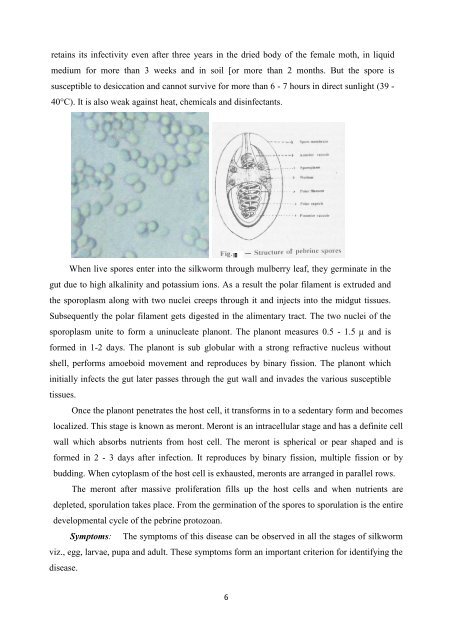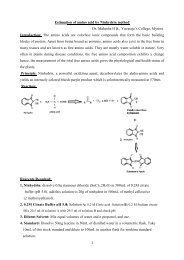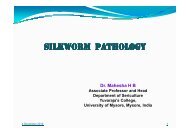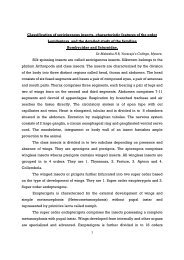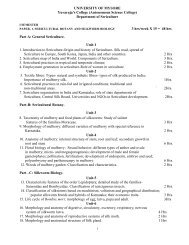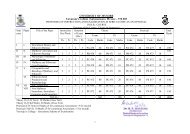silkworm grasserie and pebrine for open elective
silkworm grasserie and pebrine for open elective
silkworm grasserie and pebrine for open elective
You also want an ePaper? Increase the reach of your titles
YUMPU automatically turns print PDFs into web optimized ePapers that Google loves.
etains its infectivity even after three years in the dried body of the female moth, in liquid<br />
medium <strong>for</strong> more than 3 weeks <strong>and</strong> in soil [or mo more than 2 months. . But the spore is<br />
susceptible to desiccation <strong>and</strong> cannot survive <strong>for</strong> more than 6 - 7 hours in direct sunlight (39 -<br />
40°C). It is also weak against heat, chemicals <strong>and</strong> disinfectants.<br />
When live spores enter into the <strong>silkworm</strong> through mulberry rry leaf, they germinate in the<br />
gut due to high alkalinity <strong>and</strong> potassium ions. As a result the polar filament is extruded <strong>and</strong><br />
the sporoplasm along with two nuclei creeps through it <strong>and</strong> injects into the midgut tissues.<br />
Subsequently the polar filament gets digested in the alimentary tract. The two nuclei of the<br />
sporoplasm unite to <strong>for</strong>m a uninucleate planont. The planont measures 0.5 - 1.5 µ <strong>and</strong> is<br />
<strong>for</strong>med in 1-2 2 days. The planont is sub globular with a strong refractive nucleus without<br />
shell, per<strong>for</strong>ms amoeboid movement <strong>and</strong> reproduces by binary fission. The planont which<br />
initially infects the gut later passes through the gut wall <strong>and</strong> invades the various susceptible<br />
tissues.<br />
Once the planont ont penetrates the host cell, it trans<strong>for</strong>ms in to a sedentary dentary <strong>for</strong>m <strong>and</strong> becomes<br />
localized. ized. This stage is known as meront. Meront is an intracellular stage <strong>and</strong> has a definite cell<br />
wall which absorbs nutrients from host cell. The meront is spherical or pear sshaped<br />
<strong>and</strong> is<br />
<strong>for</strong>med in 2 - 3 days after infection. It reproduces by binary fission, multiple fission or by<br />
budding. When cytoplasm ytoplasm of the host cell is exhausted, meronts are arranged in parallel rows.<br />
The meront after massive proliferation fills up the ho host st cells <strong>and</strong> when nutrients are<br />
depleted, sporulation takes place. From the germination of the spores to sporul sporulation is the entire<br />
developmental tal cycle of the <strong>pebrine</strong> protozoan.<br />
Symptoms: The symptoms of this disease can be observed in all the stages of <strong>silkworm</strong><br />
viz., egg, larvae, pupa <strong>and</strong> adult. These symptoms <strong>for</strong>m an important criterion <strong>for</strong> identifying the<br />
disease.<br />
6


